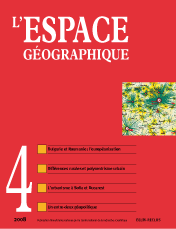

The Europeanisation of Bulgaria and Romania (2 fig.)
Which dialectics between innovation and legacy led to the institutional harmonisation that finally enabled Romania and Bulgaria to join the European Union? A completed post-Communist transition is no longer the common denominator for Europeanisation. Instead, the inequalities of the present are fuelling mobility, amid the fluctuation typical of in-between spaces. Using original new maps, the six articles here analyse various essential aspects of European integration and its geographical differentiation.
keywords: IN BETWEEN SPACE, EUROPEAN INTEGRATION, MODEL, SPATIAL INTERACTION, TERRITORIAL RECOMPOSITION
The integration of Bulgarian and Romanian rural areas: the challenge of their differences (4 fig., 1 tabl.)
With the accession of Bulgaria and Romania, rural areas characterised by a dualistic farming structure, high agrarian pressure, low productivity and extremely low alternative incomes have been brought into the European Union’s Common Agricultural Policy framework. This article makes the hypothesis that the need to change these rural areas cannot be thought of as a rapid catch-up process to bring them into line with their counterparts in Western Europe. The study describes their specific features over the evolution of their agrarian history at national and regional levels. The purpose of this analysis is focused on the implications and risks of an agrarian policy moulded on their needs, but based on instruments that have been used in very different Western European contexts.
keywords: AGRICULTURE, COMMON AGRICULTURAL POLICY, EUROPEAN INTEGRATION, RURAL DEVELOPMENT
Sofia, paradoxes of a post socialist urban policy (4 fig.)
This article reflects critically on the production of post-Socialist urban territories through a focus on the Master Plan of Sofia 2007- 2020. The Bulgarian capitaL’s propensity to mimic Western European capitals masks paradoxes in the structuring of space, land pressure and conflicts between actors that threaten to undermine the legitimacy of the project.
keywords: CAPITAL CITY, EUROPEAN INTEGRATION, LAND TENURE, SOFIA, TOWN PLANNING
Bogdan SUDITU. Bucharest: making the city between legacy and mimesis (2 fig.)
Bucharest, which aspires to play a major regional role, has to face Ceausescu’s unfinished urbanism. The capital presents various faces, the occidental and the oriental, the villager and the modernity’s window. The “transition” period had to articulate these various strata. But the hesitations between to assume the inheritances and a slavish mimicry slow down the reshaping. The liberalization of the ground and the retrocessions strenghthened the inherited structures and kept inhabitants captive. The lack of resources and the fragmented governance do not facilitate the emergence of original development ways. The European integration is then as much an opportunity as a challenge.
keywords: BUCHAREST, INHERITANCE, RESHAPING, URBANISM
The system of cities in Bulgaria and Romania. What are the prospects of polycentrism? (5 fig.)
Two complementary forces influence the urban systems of Bulgaria and Romania: the inertia of the urban hierarchy versus international openness. These two forces herald qualitative changes, which may give rise to a new characteristic: polycentrism. Whether spontaneous or a planned policy, polycentrism would be an alternative solution to the centrality of the capitals, which, caught up in metropolisation process, are incapable of coordinating balanced, cohesive development of the national territories.
keywords: EUROPEAN POLICY, ESPON, FLOW, INTERNATIONALISATION, POLYCENTRISM, URBAN SYSTEM
Decentralisation and regionalisation in Bulgaria and Romania. The ambiguities of Europeanisation (1 encadré, 1 fig.)
This article examines Europeanisation in Romania and Bulgaria as a transfer of the policies of decentralisation and regionalisation. These two principles appear to be the two sides of European territorial governance. We argue that their definitions, transfers, and implications did not take place simultaneously, due to unclear and sometimes contradictory European demands. These processes resulted in unexpected domestic policies, which leads us to refute the hypothesis of a common European model of territorial administration. The cases of Romania and Bulgaria add to our understanding of the future of the European project and to our reflection on the East-West divide in Europe.
keywords: DEMOCRATISATION, EASTERN EUROPE, EUROPEAN ENLARGEMENT, REGIONAL POLICY, STATE REFORM
Bulgaria and Romania: a geopolitical in-between within the European Union (2 fig.)
Two decades after the return of the Occident, the swinging between East and West is the living proof of the d’entre-deux spatial functioning of Bulgaria and Romania that are trying hard to become the actors of their own super-national becoming. Being situated on the main energy/power-providing routes of Europe, becoming regional/continental security and energy providers seem to be obvious priorities in a complicated context in which the Euro-Atlantic tropism is marked by an American pause/break and the coming back of Russia in the Black Sea region. Each of the two countries manages boundaries/neighbourhood depending on their traits and strategic culture.
keywords: ENERGY, EUROPEAN UNION, GEOPOLITIC, NEIGHBOURING EUROPEAN POLICY (NEP), SECURITY
Book reviews
In this issue of l’Espace géographique, you will find critical reviews of the following books
ALLEMAND S. (2007). Comment je suis devenu géographe. Paris: Le Cavalier bleu, 223 p. (Claude BATAILLON, CNRS Toulouse)
ALLEMAND S., DAGORN R.-E. (2005). Idées reçues. La géographie contemporaine. Paris: Le Cavalier bleu, 126 p. (Guilhem LABINAL, équipe E.H.GO, UMR Géographie-cités)
PELLETIER Ph. (dir.), ANQUETIL N., BOQUERAT G., GENTELLE P,. WEISBERG G. (2006). Géopolitique de l’Asie. Paris: Nathan, coll. «Nouveaux continents», 367 p. (Michel BRUNEAU, CNRS Bordeaux)
L’espace géographique 3/08![]()
![]() L’espace géographique 1/09
L’espace géographique 1/09
For subscribe or buy this issue: BELIN
![]() L’Espace géographique: contents
L’Espace géographique: contents
Last modified: December 18, 2008